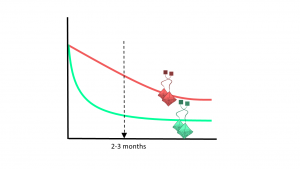What is decomposition?
A leaf falls from a tree, onto the ground and turns into soil. The soil provides nutrients to the tree, which thereby can form new leaves. Decomposition, that is decay, occurs in between, when the “decomposers” – tiny organisms, fungi and bacteria in the soil – eat up the organic matter and turn it into nutrients (a process called mineralization) and soil. Through decomposition, plants and small soil organisms are provided with food to grow and thrive. During decomposition, the greenhouse gas carbon dioxide (CO2) is released into the atmosphere. This gas can be taken up again by plants, thereby closing the carbon cycle. However, carbon dioxide is a so called greenhouse gas, as it’s concentrations in the atmosphere determine global warming
Soils are really crowded with decomposing organisms. Roughly 50,000 nematodes, 9500 mites and 750 spring tails and many, many more microbes can be found on under the surface of just one footprint. The tiny decomposers in the soil depend on different factors in their environment as they do not have a thick skin or cloths to help them to, for instance, have a constant body temperature. Therefore, decomposition is slower in cold climates and faster in warmer climates. This also means that in colder climates, less carbon dioxide will be released into the air and more is stored in the soil.
The decomposition rate depends on:
- Environmental conditions (humidity, acidity, the amount of nutrients in the soil, temperature). These factors affect the activity of the microorganisms; how fit they are and how much food they need.
- The chemical properties of the material that is going to be decomposed (e.g. a branch compared to a flower or plastic compared to paper). This is because microorganisms prefer some materials over other. Just like us humans, microorganisms love to eat sugar but are not so fond of harder materials like wood.
- Which decomposers are present. Mites, worms, fungi and bacteria all break down the different parts of the plant material at different speeds, as each of them has its own preferences.
Methods to study decomposition
To measure decay rates of dead plant material (litter), you need to put a certain amount of litter in a plastic mesh bag. The holes in the mesh will allow microorganisms to enter and consume the litter, but the plastic bag will prevent the litter from being lost. To measure the decay of the plant material in the bag you need to put this bag in the soil. The weight loss of the material after a certain amount of time will show you how fast the decay is at the location where you buried the bag. In the TBI-method we do not make such litterbags ourselves. We buy them in the store: tea bags. Green tea and Rooibos tea leaves are plant material, and will therefore decay like other organic material. The TBI method measures decay of plant material by using two types of tea bags (Green and Rooibos) as standard plant litter (Keuskamp et al., 2013) in plastic mesh bags. Tea bags are placed in the soil and weight loss is determined after three months. Tea is not only used as a standard litter. From the weight loss of Rooibos and Green tea we obtain two parameters that are indicative of two different phases of the decay curve. Usually, decay is initially rather fast when all the material that is easy to decay is consumed. Second, the weight loss curve over time levels off, when decay is much slower as only the more recalcitrant material is left. We call this latter phase stabilization. With the decay of easy to decompose green tea (green line, Figure 1) one can determine how much of the material is stabilized (S). Rooibos tea decays much slower (red line, Figure 1) and after three months, it is still in the first phase of decay. Thereby, the weight loss of Rooibos tea after three months gives us a measure for the initial decay rate (k).
With the decay of easy to decompose green tea (green line, Figure 1) one can determine how much of the material is stabilized (S). Rooibos tea decays much slower (red line, Figure 1) and after three months, it is still in the first phase of decay. Thereby, the weight loss of Rooibos tea after three months gives us a measure for the initial decay rate (k).
With the TBI method it becomes easy to compare sites in an easy and standardized way and test climatic forcing on decay with a high resolution.
Project aim
- To create a global soil map of decay rates.
- To test relations between environment and decay on a global scale.
The TBI method can be used to
- Test the effect of climate in large climate gradients
- Test experimental treatment effects
- Educate students on soil processes
Want to join?
If this got you exited, you are welcome to become a TBI researcher too!
Make sure you have the right tea, a precise scale and a spoon or scoop to dig a hole. All details and tips and tricks to find tea or a scale can be found under methods.
If you are planning on digging down a lot of tea bags on many different locations, you can apply for co-authorship of the database and its analysis. Details can be found here.
If you want to join with your school class, please check out the lessonplan or send an email to email hidden; JavaScript is required.
If you want to give this project media attention, please contact us.
